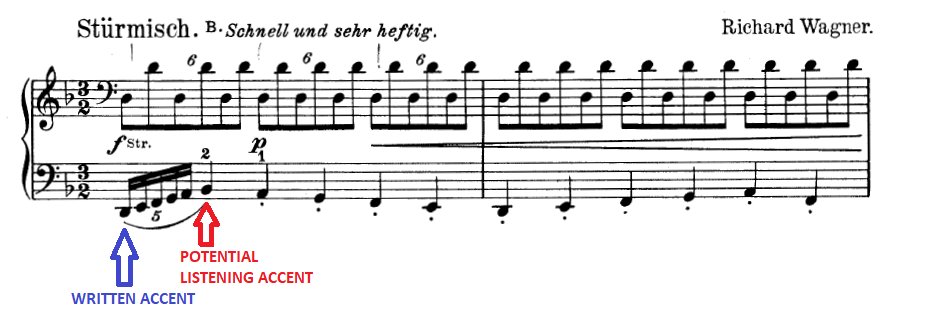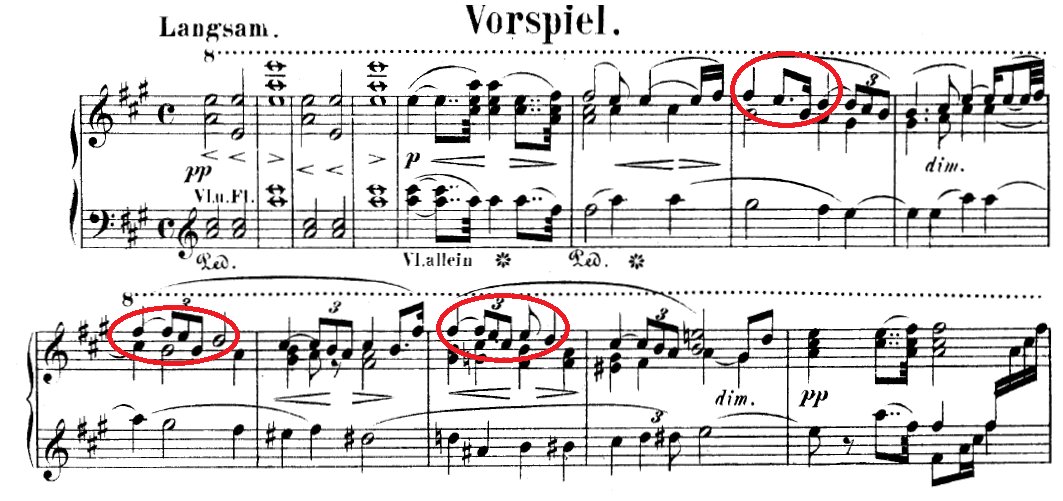#WednesdayWagner Now that the summer is about to end (Sommerdämmerung), let's resume this weekly digest of my music. Today: DIE WALKÜRE'S STORM. AN EXAMPLE OF ECONOMY OF MEANS IN WAGNER.
#TwitterCultural #SummerReading #Wagner #GreatestComposerEver
#TwitterCultural #SummerReading #Wagner #GreatestComposerEver
#WednesdayWagner The beginning of 'Die Walküre' is an absolute slap on the face that immerses you in a different atmosphere of 'Das Rheingold'. Indeed, the world of Gods and Nibelungs is replaced by the world of humans.
#WednesdayWagner There are many elements that contribute to the tension of this beginning. Let's mention, firstly, the 'obstinato' strategy by repeating the same idea with some transformations, as this contraction at the very beginning #TwitterCultural #SummerReading 

#WednesdayWagner Another important aspect is the rhythm: the burst of 16th notes gives the perception in the ear that the accent is on the 2nd pitch (b flat) instead on the 1st one (d). At least, I perceived that in the first listening of the piece #TwitterCultural #SummerReading 

#WednesdayWagner But, do you feel that this motive sounds familiar? Sure! You will listen to a small variation of it at the ending of the opera ... is the 'Sleeping Brünnhilde' motive BUT here it appears in minor mode! #TwitterCultural #SummerReading
#WednesdayWagner How is the 'Sleeping Brünnhilde' leitmotif transformed into the 'Storm' leitmotif? As indicated in the figure below. For the sake of clarity, I have started in D Major instead E major (as it appears in Act 3) #TwitterCultural #SummerReading 

#WednesdayWagner Of course, some pitches have been included to form Wotan's descending scale (see thread below), but the 6th interval at the beginning and the harmony is clearly the one in Brünnhilde's motivic world
#TwitterCultural
#TwitterCultural
https://twitter.com/Wagner2_0/status/1280905032062377985?s=20
#WednesdayWagner As an example, in Wotan's final monologue (Leb' wohl), when the sleeping motive appears everywhere, sometimes the harmonic basis is a minor chord and, MAGIC, the relationship between the storm motive is clear! You can see below
#TwitterCultural #SummerReading
#TwitterCultural #SummerReading

#WednesdayWagner But the power of this motive is so high that Wagner uses it during the whole prelude of the opera. Play again the prelude (link above) from 1.08 to 1.20 ... In the basses, there is the quasi-inversion of the motive! Gorgeous
#TwitterCultural #SummerReading
#TwitterCultural #SummerReading

#WednesdayWagner The rapid burst of pitches is now descending, and the scale moves upwards. I call it 'quasi-inversion' because the 1st big interval is not a 6th, but a 7th. But the inversion can be heard in a really clear way
#TwitterCultural #SummerReading
#TwitterCultural #SummerReading
#WednesdayWagner Question: Why would Wagner enlarge this 6th interval to make it a 7th? My answer, not the real Wagner but yours trully on Twitter 🙂: To allow generating a descending pattern, since the returning pitch is not the same now.
#TwitterCultural #SummerReading
#TwitterCultural #SummerReading
#WednesdayWagner Indeed, look at the first pitch of each motive (marked in red): You can notice ALSO THERE the Wotan's descending scale, which is indeed the one used in the motive itself
#TwitterCultural #SummerReading
#TwitterCultural #SummerReading

#WednesdayWagner Another excerpt: If you listen to 1.32, when the 'Donner' motive appears in the brasses, let's see the patterns done by the string instruments: Surprise! The storm motive in a perfect canon with 3 voices! Impressive
#TwitterCultural #SummerReading
#TwitterCultural #SummerReading

#WednesdayWagner So the 'Storm' leitmotif is not only a variation (or a seed!) of Brünnhilde's sleeping motive, but it's also constructed to allow such a canon (not all musical ideas can be worked in this way). Nothing is left to chance here!
#TwitterCultural #SummerReading
#TwitterCultural #SummerReading
#WednesdayWagner Thus, you can see that the whole Prelude of this opera is based almost exclusively on one single idea, the one that will serve as a conclusion of the opera more than 3 hours laters. Isn't it wonderful?#TwitterCultural #SummerReading #Wagner #Genius
@threadreaderapp unroll
• • •
Missing some Tweet in this thread? You can try to
force a refresh







